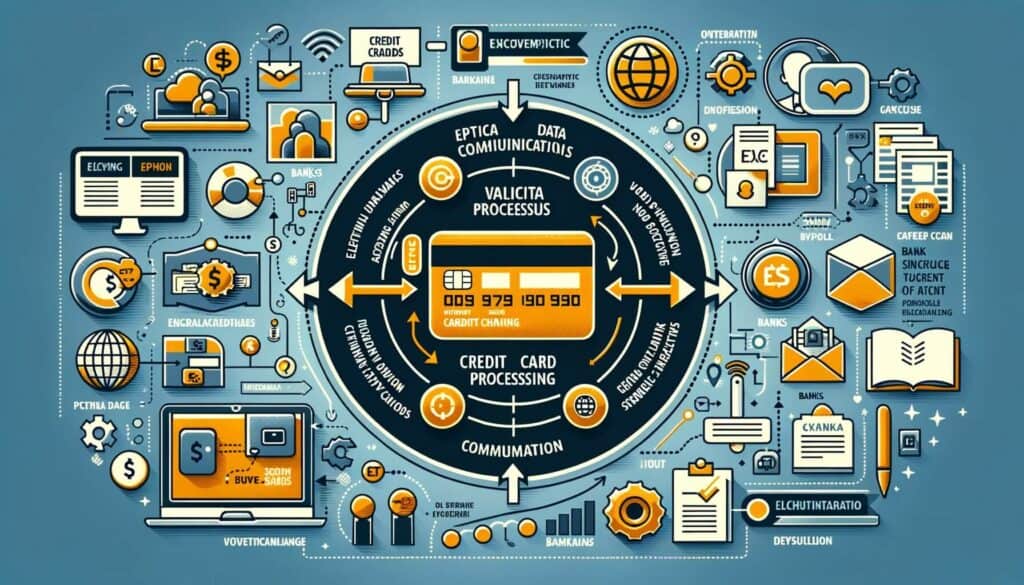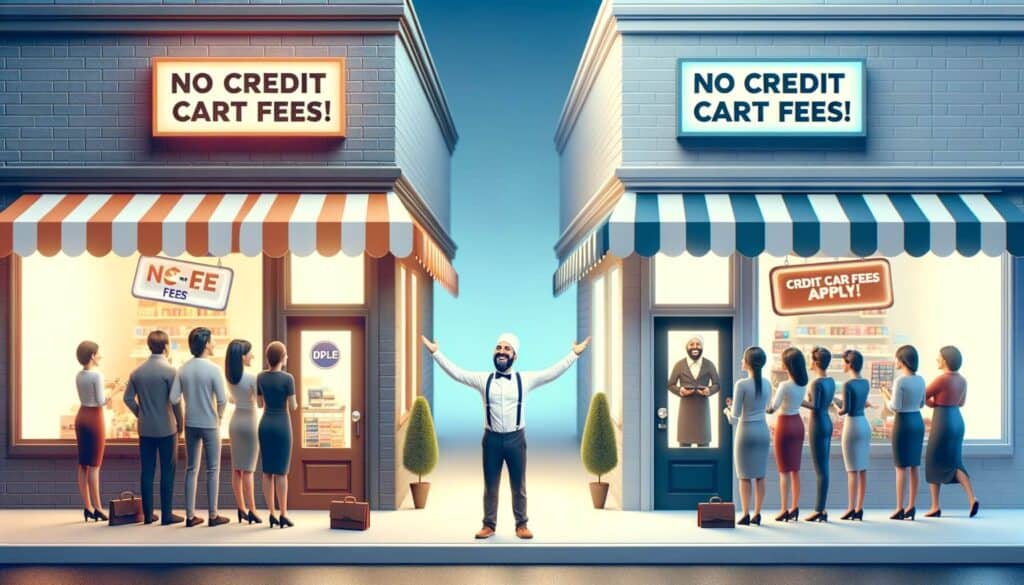
By Mollie Mills February 27, 2025
In today’s digital age, credit card payments have become the norm for consumers. As a result, merchants must adapt to this trend by offering convenient and secure payment options. However, traditional credit card processing fees can eat into a merchant’s profits. This is where no-fee credit card processing comes into play.
In this comprehensive guide, we will explore the world of no-fee credit card processing, its benefits, different models, how it works, factors to consider when choosing a provider, common misconceptions, tips for maximizing its benefits, and frequently asked questions.
Understanding the Basics of Credit Card Processing

Before diving into the world of no-fee credit card processing, it is essential to understand the basics of credit card processing. When a customer makes a purchase using a credit card, the transaction goes through a series of steps to ensure the payment is authorized and processed. These steps involve the merchant, the customer’s credit card issuer, and the payment processor.
The process begins when the customer swipes, inserts, or taps their credit card at the merchant’s point-of-sale (POS) system. The POS system then sends the transaction details to the payment processor, which acts as an intermediary between the merchant and the customer’s credit card issuer. The payment processor verifies the customer’s credit card information, checks for available funds, and sends an authorization request to the credit card issuer.
If the credit card issuer approves the transaction, the payment processor sends an authorization code back to the merchant’s POS system. The merchant can then complete the sale, and the payment processor transfers the funds from the customer’s credit card issuer to the merchant’s bank account. However, this process typically involves fees that merchants must pay for each transaction.
The Benefits of No-Fee Credit Card Processing for Merchants

No-fee credit card processing offers several benefits for merchants. The most significant advantage is the elimination of transaction fees, which can save merchants a significant amount of money over time. By eliminating these fees, merchants can increase their profit margins and reinvest the savings into their business.
Additionally, no-fee credit card processing can attract more customers. In a competitive market, offering a no-fee payment option can be a differentiating factor that entices customers to choose a particular merchant over others. Customers appreciate the transparency and convenience of not having to pay additional fees when making a purchase.
Furthermore, no-fee credit card processing can improve cash flow for merchants. Without the burden of transaction fees, merchants can receive the full payment amount immediately, rather than waiting for funds to be transferred after deducting fees. This can help with inventory management, paying suppliers, and other business expenses.
Exploring Different No-Fee Credit Card Processing Models

There are various models of no-fee credit card processing that merchants can choose from. Each model has its own advantages and considerations, so it is essential to understand the options before making a decision.
One popular model is the cash discount model. In this model, merchants offer a discount to customers who pay with cash or debit cards. By doing so, the merchant can offset the cost of credit card processing fees. This model is legal in most states, as long as the discount is clearly disclosed to customers.
Another model is the surcharge model. In this model, merchants add a small surcharge to credit card transactions to cover the cost of processing fees. However, it is important to note that surcharging is subject to legal restrictions in some states and may require compliance with specific regulations.
Lastly, some payment processors offer no-fee credit card processing as part of their services. These processors may charge a monthly fee or a percentage of sales to cover their costs. However, this fee is often lower than traditional transaction fees, making it an attractive option for merchants.
How No-Fee Credit Card Processing Works: A Step-by-Step Guide

To understand how no-fee credit card processing works, let’s walk through a step-by-step guide:
1. Merchant sets up a no-fee credit card processing solution: The merchant chooses a payment processor or provider that offers a no-fee credit card processing solution. The provider sets up the necessary infrastructure and software to enable no-fee transactions.
2. Customer makes a purchase: The customer selects their items and proceeds to the checkout. They choose to pay with a credit card.
3. Payment processor calculates the fee: The payment processor calculates the transaction fee based on the total amount of the purchase.
4. Fee is added to the customer’s total: In the cash discount model, the fee is added to the customer’s total, and they have the option to pay the full amount or choose an alternative payment method to avoid the fee. In the surcharge model, the fee is added as a separate line item on the customer’s receipt.
5. Payment is processed: The payment processor handles the transaction, authorizes the payment, and transfers the funds from the customer’s credit card issuer to the merchant’s bank account.
6. Merchant receives the full payment: In a no-fee credit card processing model, the merchant receives the full payment amount without any deductions for transaction fees.
Factors to Consider When Choosing a No-Fee Credit Card Processing Provider
When choosing a no-fee credit card processing provider, there are several factors to consider:
1. Compatibility with existing systems: Ensure that the provider’s solution is compatible with your existing POS system or e-commerce platform. Seamless integration is crucial to avoid disruptions to your business operations.
2. Pricing structure: Understand the provider’s pricing structure and any additional fees that may be involved. While the goal is to eliminate transaction fees, there may still be other costs associated with the service.
3. Security and compliance: Verify that the provider adheres to industry standards for data security and compliance with payment card industry regulations. Protecting your customers’ payment information is essential for building trust and maintaining a good reputation.
4. Customer support: Evaluate the provider’s customer support capabilities. Prompt and reliable support is crucial in case of any issues or technical difficulties.
5. Reputation and reviews: Research the provider’s reputation and read reviews from other merchants who have used their services. This can give you insights into the provider’s reliability and customer satisfaction.
Common Misconceptions and Myths about No-Fee Credit Card Processing
Despite the benefits and growing popularity of no-fee credit card processing, there are still some misconceptions and myths surrounding this payment method. Let’s debunk a few of them:
1. No-fee credit card processing is illegal: This is a common misconception. No-fee credit card processing is legal in most states, as long as it is properly disclosed to customers and complies with relevant regulations.
2. Customers will be deterred by the added fee: While some customers may be deterred by the added fee, studies have shown that the majority of customers are willing to pay a small fee for the convenience of using a credit card. Offering alternative payment methods, such as cash or debit cards, can also mitigate this concern.
3. No-fee credit card processing is only suitable for small businesses: No-fee credit card processing can benefit businesses of all sizes. Whether you are a small business or a large enterprise, eliminating transaction fees can have a significant impact on your bottom line.
4. No-fee credit card processing providers are unreliable: This myth stems from the misconception that eliminating transaction fees means sacrificing quality or reliability. However, many reputable payment processors offer no-fee credit card processing solutions that are secure, reliable, and backed by excellent customer support.
Tips and Best Practices for Maximizing the Benefits of No-Fee Credit Card Processing
To maximize the benefits of no-fee credit card processing, consider the following tips and best practices:
1. Educate your customers: Clearly communicate the no-fee credit card processing model to your customers. Explain the benefits and convenience of using a credit card, even with the added fee, and offer alternative payment methods to accommodate different preferences.
2. Choose the right model for your business: Evaluate the different models of no-fee credit card processing and choose the one that aligns best with your business needs and customer preferences. Consider factors such as legal restrictions, customer acceptance, and ease of implementation.
3. Optimize your pricing strategy: Adjust your pricing strategy to account for the elimination of transaction fees. Consider whether you can offer lower prices or additional incentives to attract more customers and increase sales.
4. Monitor and analyze your data: Use analytics tools to track and analyze your sales data. Look for patterns and insights that can help you optimize your pricing, inventory management, and overall business strategy.
5. Stay informed about regulations: Keep up-to-date with any changes in regulations regarding no-fee credit card processing. Compliance is crucial to avoid legal issues and maintain a positive relationship with your customers.
Frequently Asked Questions (FAQs) about No-Fee Credit Card Processing
Q: Is no-fee credit card processing legal?
A: Yes, no-fee credit card processing is legal in most states, as long as it is properly disclosed to customers and complies with relevant regulations.
Q: Can I offer no-fee credit card processing for online transactions?
A: Yes, many payment processors offer no-fee credit card processing solutions for both in-person and online transactions.
Q: Will customers be deterred by the added fee?
A: While some customers may be deterred by the added fee, studies have shown that the majority of customers are willing to pay a small fee for the convenience of using a credit card.
Q: Can I still offer alternative payment methods?
A: Yes, offering alternative payment methods, such as cash or debit cards, can accommodate customers who prefer not to pay the added fee.
Q: How do I choose the right no-fee credit card processing provider?
A: Consider factors such as compatibility with your existing systems, pricing structure, security and compliance, customer support, and reputation when choosing a provider.
Conclusion
No-fee credit card processing is a game-changer for merchants, offering a way to eliminate transaction fees and increase profit margins. By understanding the basics of credit card processing, exploring different models, and considering factors when choosing a provider, merchants can make informed decisions and maximize the benefits of no-fee credit card processing.
Despite some misconceptions, no-fee credit card processing is legal, customer-friendly, and suitable for businesses of all sizes. By following best practices and staying informed about regulations, merchants can leverage this payment method to attract more customers, improve cash flow, and optimize their overall business strategy.